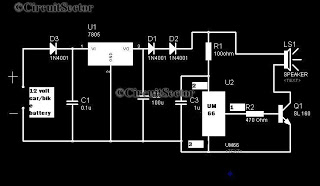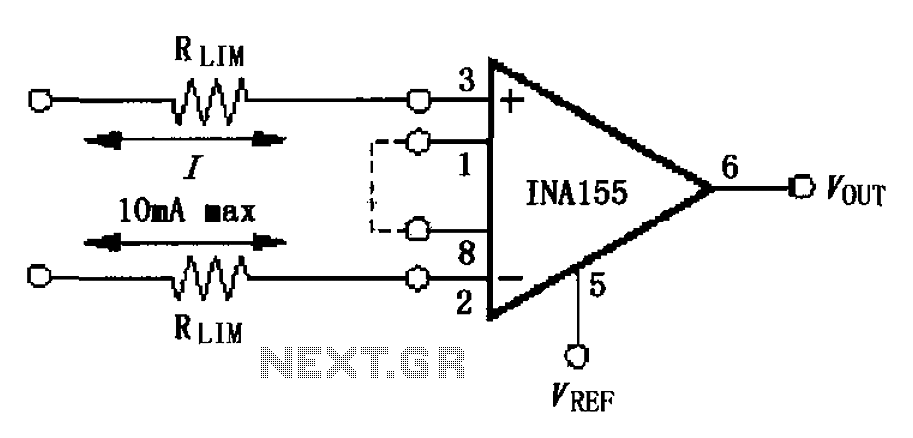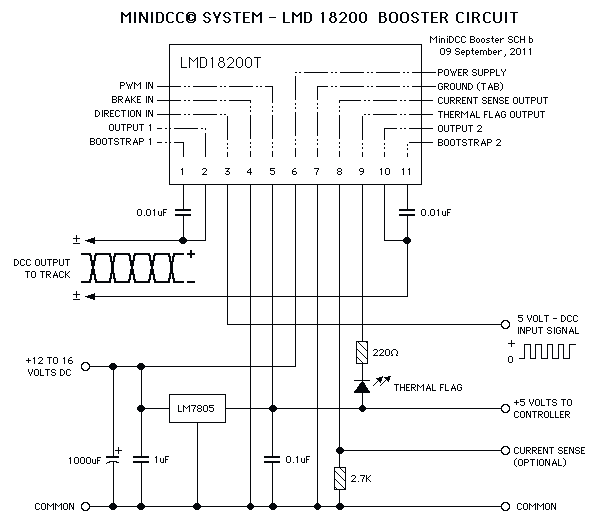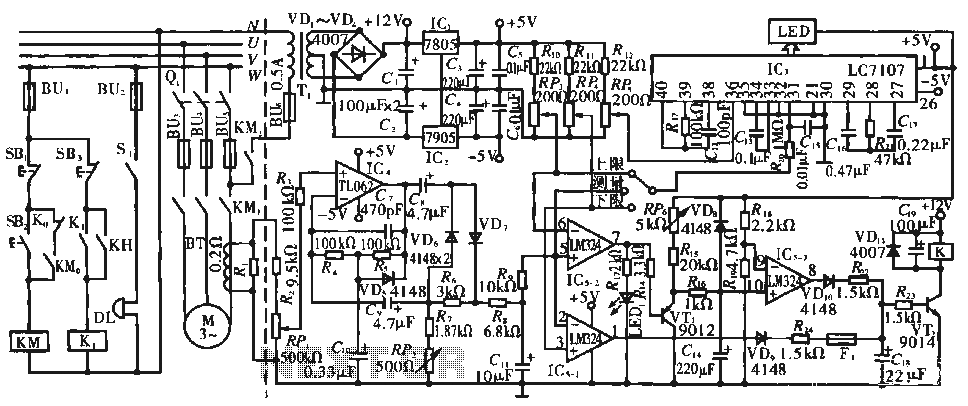
110Db Beeper Circuit
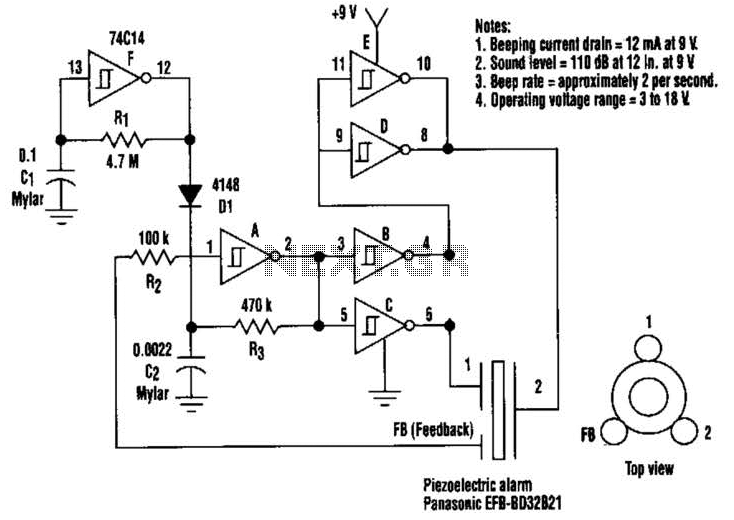
This circuit generates a loud sound of 110 dB using a 9 V power supply. It incorporates a single 74C14 (CD40106B) CMOS hex inverting Schmitt-trigger IC, which is utilized with a piezoelectric device that includes a feedback terminal. The feedback terminal is connected to a central area on the piezoelectric wafer. When the beeper operates at resonance, the feedback signal reaches its peak. One inverter from the 74C14 is configured as an astable oscillator, with a frequency set to be five times lower than the 3.2 kHz resonant frequency of the piezoelectric device. Feedback from the third pin of the beeper enhances the driving frequency to ensure optimal sound output. Additionally, four more inverter sections of the IC are arranged to create two separate drivers. The output of one inverter section is cross-connected to the input of another, resulting in a differential drive signal that produces approximately 18 V peak-to-peak when measured across the beeper. The final inverter section is configured as a second astable oscillator, operating at around 2 Hz, which modulates the main oscillator on and off through a diode. For a continuous tone, the modulation circuit can be removed.
The circuit design effectively utilizes the 74C14 CMOS IC to create a high-output audio signal suitable for applications requiring loud sound generation. The critical component, the piezoelectric device, is chosen for its ability to convert electrical energy into sound energy efficiently. The feedback mechanism is essential for maintaining the resonance of the piezoelectric element, ensuring that the generated sound is at its maximum loudness.
The astable oscillator configuration is fundamental in establishing a continuous oscillation at a frequency that is well-suited for the piezoelectric device. By setting the frequency to five times lower than the resonant frequency of 3.2 kHz, the circuit ensures that the piezoelectric element is driven effectively, allowing it to vibrate at its optimal operating point.
The differential drive configuration created by cross-wiring the inverter sections enhances the output voltage across the beeper, providing a robust sound output. This arrangement allows for an increase in the peak-to-peak voltage to about 18 V, significantly amplifying the sound produced by the piezoelectric device.
The inclusion of a second astable oscillator functioning at approximately 2 Hz introduces a modulation effect, which can be used to create a pulsing sound effect. The ability to gate the main oscillator on and off via a diode provides flexibility in sound output, allowing for variations in tone and duration. However, for applications requiring a steady tone, the modulation circuit can be omitted, simplifying the design while maintaining high sound output.
Overall, this circuit exemplifies a practical approach to generating high-decibel sound using a straightforward combination of CMOS technology and piezoelectric actuation, making it suitable for various audio signaling applications. This circuit will generate an ear-splitting 110 dB from 9 V. The setup uses a single 74C14 (CD40106B) CMOS hex inverting Schmitt-trigger IC, wliich must be used with a piezoelectric device with a feedback terminal. The feedback terminal is attached to a central region on the piezoelectric wafer. When the beeper is driven at resonance, the feedback signal peaks. One inverter of the 74C14 is wired as an astable oscillator, The frequency is chosen to be 5 times lower than the 3.2 kHz resonant frequency of the piezoelectric device.
Feedback from the third pin of the beeper reinforces the correct drive frequency to ensure maximum sound output. Four other inverter sections of the IC are wired to form two separate drivers. The output of one section is cross-wired to the input of the second section. The differential drive signal that results produces about 18-V p-p when measured across the beeper. The last inverter section is wired as a second astable oscillator with a frequency of about 2 Hz. It gates the main oscillator on and off through a diode. For a continuous tone, the modulation circuit can be deleted.
The circuit design effectively utilizes the 74C14 CMOS IC to create a high-output audio signal suitable for applications requiring loud sound generation. The critical component, the piezoelectric device, is chosen for its ability to convert electrical energy into sound energy efficiently. The feedback mechanism is essential for maintaining the resonance of the piezoelectric element, ensuring that the generated sound is at its maximum loudness.
The astable oscillator configuration is fundamental in establishing a continuous oscillation at a frequency that is well-suited for the piezoelectric device. By setting the frequency to five times lower than the resonant frequency of 3.2 kHz, the circuit ensures that the piezoelectric element is driven effectively, allowing it to vibrate at its optimal operating point.
The differential drive configuration created by cross-wiring the inverter sections enhances the output voltage across the beeper, providing a robust sound output. This arrangement allows for an increase in the peak-to-peak voltage to about 18 V, significantly amplifying the sound produced by the piezoelectric device.
The inclusion of a second astable oscillator functioning at approximately 2 Hz introduces a modulation effect, which can be used to create a pulsing sound effect. The ability to gate the main oscillator on and off via a diode provides flexibility in sound output, allowing for variations in tone and duration. However, for applications requiring a steady tone, the modulation circuit can be omitted, simplifying the design while maintaining high sound output.
Overall, this circuit exemplifies a practical approach to generating high-decibel sound using a straightforward combination of CMOS technology and piezoelectric actuation, making it suitable for various audio signaling applications. This circuit will generate an ear-splitting 110 dB from 9 V. The setup uses a single 74C14 (CD40106B) CMOS hex inverting Schmitt-trigger IC, wliich must be used with a piezoelectric device with a feedback terminal. The feedback terminal is attached to a central region on the piezoelectric wafer. When the beeper is driven at resonance, the feedback signal peaks. One inverter of the 74C14 is wired as an astable oscillator, The frequency is chosen to be 5 times lower than the 3.2 kHz resonant frequency of the piezoelectric device.
Feedback from the third pin of the beeper reinforces the correct drive frequency to ensure maximum sound output. Four other inverter sections of the IC are wired to form two separate drivers. The output of one section is cross-wired to the input of the second section. The differential drive signal that results produces about 18-V p-p when measured across the beeper. The last inverter section is wired as a second astable oscillator with a frequency of about 2 Hz. It gates the main oscillator on and off through a diode. For a continuous tone, the modulation circuit can be deleted.
